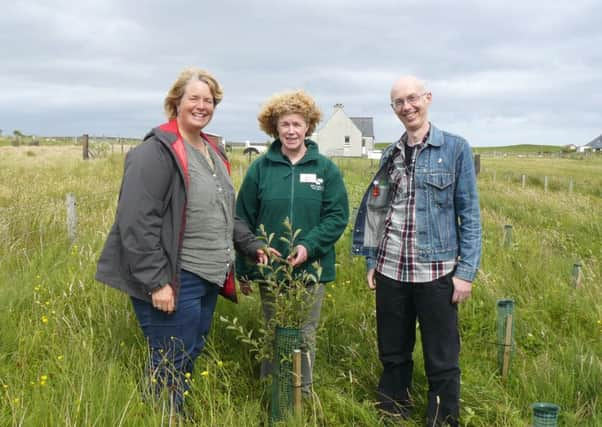Trees '˜do grow' on remote Isle of Lewis' landscape


The head of a woodland conservation charity has spoken of how impressed she is with the success of Point and Sandwick Trust’s Croft Woodlands Project.
Woodland Trust chief executive Beccy Speight, from Lincolnshire, spent some time on Lewis as part of a whistle-stop tour of the Highlands and Islands, and met Eleanor Garty, North Scotland Woodland Creation Manager.
Advertisement
Hide AdAdvertisement
Hide AdThey had visited a number of other projects before coming to Lewis, including the Loch Arkaig Caledonian Pinewood, which the Woodland Trust recently bought in conjunction with a local community group and plans to restore to its former glory.
They visited other croft woodlands too, at Grantown on Spey and near Dingwall, but she said Lewis had been a “genuine highlight” and also a surprise, in terms of how well the new trees were doing.
They visited crofts in a number of areas, including Point, Back and Tolsta, and Beccy said the visit would help inform her decision making in the future.
She revealed she had been drawn to the island anyway, having spent a recent holiday here, but was pleased to return on official business.
She said: “It’s so good for me to get out and meet some of the staff who are doing the work on the ground and find out how it’s going.
“I wanted to come up and see some of the work that we’re doing across the Highlands. I was particularly keen to see some of the work that we’re doing here in the Western Isles on the crofting projects. This is really exciting for us. We do ‘woodland creation’ — planting new trees — across the UK but I think the situation here is more challenging.”
These challenges can include the climate — she noted the Tolsta site was “very draughty” while the Point crofts were wet — plus the topography and the need to comply with the crofting system.
Advertisement
Hide AdAdvertisement
Hide AdShe was, however, impressed by “the enthusiasm and commitment of the people who are putting the trees into their croft”, adding: “There’s a real commitment to making it work and I think that’s really important because the aftercare is very important.
“You will lose some trees here because the circumstances are quite challenging. I came out thinking the rate of dead trees might be quite high… but it’s not. “I was really impressed by how few were actually being lost and I think that’s because people are really putting the effort in. We saw some really good trees.”
The Croft Woodlands project is a partnership between Point and Sandwick Trust, the Woodland Trust, Forestry Commission Scotland, the Scottish Crofting Federation and Shetland Amenity Trust.
It aims to create 70 hectares of new woodland on croft land throughout the Western Isles by 2020 and more than 500 hectares throughout the crofting counties of Scotland.
Point and Sandwick Trust are supporting it by funding project officer Viv Halcrow’s post. The project was launched in March last year and part of Viv’s job is helping people apply for funding, be it from the Forestry Commission through the Scottish Rural Development Programme Forestry Grant Scheme or the Woodland Trust for smaller plantations.
Viv has now had about 250 inquiries from Barra to Ness and has managed to make site visits to around half of them so far.
Viv said: “I think the interest has exceeded everybody’s expectations. There’s a huge level of interest and hopefully over that five-year period we’ll manage to get to everybody and get as many trees on the ground as possible.”
Advertisement
Hide AdAdvertisement
Hide AdMany of the Western Isles plantations are relatively small scale, at under 1000 trees, but they still make “a real difference” to the croft and smaller numbers mean people can more realistically manage the planting and aftercare themselves, said Viv.
Motivations have included creating shelter — whether for livestock, vegetables or houses — as well as encouraging wildlife and pollinators and simply the desire to see more trees.
Viv’s knowledge of what will suit the conditions is important — native broadleaves like willow, birch and hazel do well, having a resilience to salt-laden winds — and Beccy hailed the relationship between project officer Viv, the Woodland Trust as the UK agency and Point and Sandwick Trust as crucial to the success of the project.
“Point and Sandwick Trust have been so supportive. It absolutely wouldn’t have happened without the support that the trust has given us both financially but also in terms of moral support for Viv.”
She spoke of the “amazing” story of how Point and Sandwick Trust had realised their dream of a community-owned wind farm at Beinn Ghrideag, which makes annual profits of around £500,000.
“I’ve heard a bit of the story about how it all came to happen in terms of the wind turbines and it just sounds very gutsy and very independently minded,” she said.
“I think that spirit is what I’ve seen in the people we’ve talked to — not giving up, being resilient and just carrying on and making stuff happen.
Advertisement
Hide AdAdvertisement
Hide Ad“I think it’s brilliant that the trust has chosen to invest some of its money in this particular project. To have said, ‘right, let’s see if we can make this happen, not just in Lewis but throughout the Western Isles’, shows a real generosity of spirit and an act of faith, to say, ‘we think this is possible’.
“The big thing for me is seeing trees going into a landscape like this where a lot of people said, ‘oh trees don’t grow here — it’s too difficult to do’.
“Just seeing it happen, and seeing people do it, is great. Because trees do grow here and we’re building even more evidence of that.”
